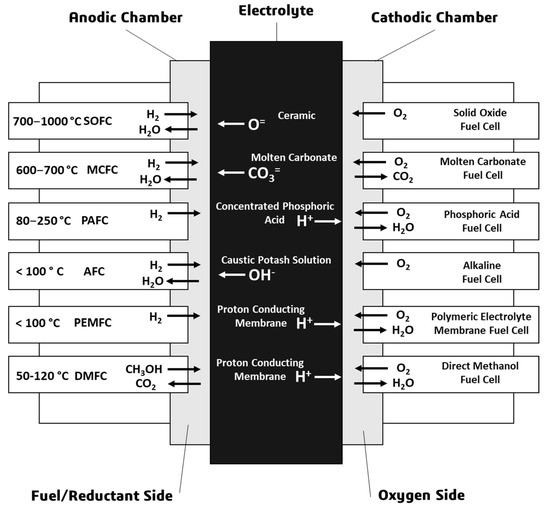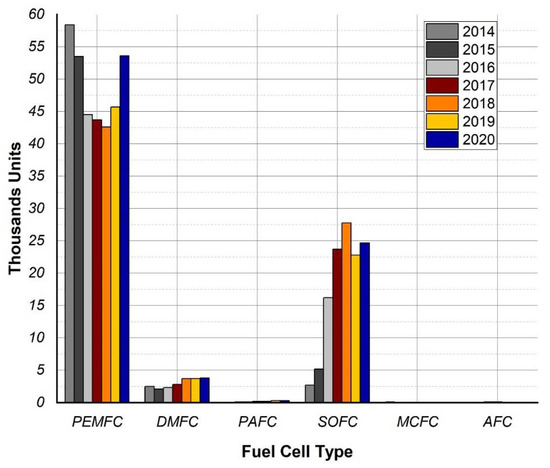
| Version | Summary | Created by | Modification | Content Size | Created at | Operation |
|---|---|---|---|---|---|---|
| 1 | Matteo Genovese | + 1724 word(s) | 1724 | 2021-08-18 12:00:17 | | | |
| 2 | Lindsay Dong | Meta information modification | 1724 | 2021-10-09 05:41:58 | | |
Video Upload Options
Fuel cell technologies have several applications in stationary power production, such as units for primary power generation, grid stabilization, systems adopted to generate backup power, and combined-heat-and-power configurations (CHP). The main sectors where stationary fuel cells have been employed are (a) micro-CHP, (b) large stationary applications, (c) UPS, and IPS. The fuel cell size for stationary applications is strongly related to the power needed from the load. Since this sector ranges from simple backup systems to large facilities, the stationary fuel cell market includes few kWs and less (micro-generation) to larger sizes of MWs. The design parameters for the stationary fuel cell system differ for fuel cell technology (PEM, AFC, PAFC, MCFC, and SOFC), as well as the fuel type and supply.
1. Introduction
Among the several options that the scientific community is recognizing as key elements to address climate changes [1] and fossil fuel dependence [2], fuel cell (FC) technologies are worldwide recognized as the best options to decarbonize the stationary power production sectors [3], including primary power generation units, backup power systems, and combined-heat-and-power configurations (CHP) [4].
Fuel cell technologies are capable of providing very high efficiency, minimum pollution, and high reliability [5][6]. The technology is applied in industries ranging from a distributed generation for power companies [7][8][9], to residential and industrial co-generation [10], portable generation [11], and vehicles [12]. The fuel cells are receiving considerable attention as they constitute, thanks to their ability to optimally use hydrogen [13], the key technology for the development of this energy carrier [14][15]. The design parameters for the stationary fuel cell system differ for fuel cell technology (PEM, AFC, PAFC, MCFC, and SOFC), as well as the fuel choice and supply [16].
The main sectors where stationary fuel cells have been employed are (a) micro-CHP, (b) large stationary applications, (c) uninterruptible power supply (UPS), and integrated power supply (IPS). The fuel cell size for stationary applications is strongly related to the power needed from the load. Since this sector ranges from simple backup systems to large facilities, the stationary fuel cell market includes few kWs and even fewer (micro-generation) and larger sizes of MWs.
2. The Key Role of Fuel Cell Technology
-
Hydrogen injection and burned via direct combustion;
-
Hydrogen oxidation via catalytic combustion, with no-flame production;
-
Production of water as steam, when pure hydrogen is combined with oxygen at high temperature;
-
Hydrogen as reactant gas in a fuel cell operation.

3. Fuel Cell Installations


4. Niche Applications
5. Breakdown of the Current Costs
References
- Maroufmashat, A.; Fowler, M. Transition of future energy system infrastructure; through power-to-gas pathways. Energies 2017, 10, 1089.
- Kilkiş, B.; Kilkiş, Ş. Hydrogen economy model for nearly net-zero cities with exergy rationale and energy-water nexus. Energies 2018, 11, 1226.
- Wołowicz, M.; Kolasiński, P.; Badyda, K. Modern small and microcogeneration systems—A review. Energies 2021, 14, 785.
- Sharaf, O.Z.; Orhan, M.F. An overview of fuel cell technology: Fundamentals and applications. Renew. Sustain. Energy Rev. 2014, 32, 810–853.
- Alaswad, A.; Omran, A.; Sodre, J.R.; Wilberforce, T.; Pignatelli, G.; Dassisti, M.; Baroutaji, A.; Olabi, A.G. Technical and commercial challenges of proton-exchange membrane (Pem) fuel cells. Energies 2021, 14, 144.
- Shigeta, N.; Hosseini, S.E. Sustainable development of the automobile industry in the united states, europe, and japan with special focus on the vehicles’ power sources. Energies 2021, 14, 78.
- Ahmed, K.; Farrok, O.; Rahman, M.M.; Ali, M.S.; Haque, M.M.; Azad, A.K. Proton exchange membrane hydrogen fuel cell as the grid connected power generator. Energies 2020, 13, 6679.
- Kang, H.S.; Kim, M.H.; Shin, Y.H. Thermodynamic modeling and performance analysis of a combined power generation system based on HT-PEMFC and ORC. Energies 2020, 13, 6163.
- Popel’, O.S.; Tarasenko, A.B.; Filippov, S.P. Fuel cell based power-generating installations: State of the art and future prospects. Therm. Eng. 2018, 65, 859–874.
- Al-Bonsrulah, H.A.Z.; Alshukri, M.J.; Mikhaeel, L.M.; Al-Sawaf, N.N.; Nesrine, K.; Reddy, M.V.; Zaghib, K. Design and simulation studies of hybrid power systems based on photovoltaic, wind, electrolyzer, and pem fuel cells. Energies 2021, 14, 2643.
- Chou, C.J.; Jiang, S.B.; Yeh, T.L.; Tsai, L.D.; Kang, K.Y.; Liu, C.J. A portable direct methanol fuel cell power station for long-term internet of things applications. Energies 2020, 13, 3547.
- Un-Noor, F.; Padmanaban, S.; Mihet-Popa, L.; Mollah, M.N.; Hossain, E. A comprehensive study of key electric vehicle (EV) components, technologies, challenges, impacts, and future direction of development. Energies 2017, 10, 1217.
- Valencia, G.; Benavides, A.; Cárdenas, Y. Economic and environmental multiobjective optimization of a wind-solar-fuel cell hybrid energy system in the Colombian Caribbean region. Energies 2019, 12, 2119.
- Cerniauskas, S.; Grube, T.; Praktiknjo, A.; Stolten, D.; Robinius, M. Future hydrogen markets for transportation and industry: The impact of CO2 taxes. Energies 2019, 12, 4707.
- Boait, P.J.; Greenough, R. Can fuel cell micro-CHP justify the hydrogen gas grid? Operating experience from a UK domestic retrofit. Energy Build. 2019, 194, 75–84.
- Herrmann, A.; Mädlow, A.; Krause, H. Key performance indicators evaluation of a domestic hydrogen fuel cell CHP. Int. J. Hydrogen Energy 2019, 44, 19061–19066.
- Ellamla, H.R.; Staffell, I.; Bujlo, P.; Pollet, B.G.; Pasupathi, S. Current status of fuel cell based combined heat and power systems for residential sector. J. Power Sources 2015, 293, 312–328.
- Larminie, J.; Dicks, A. Fuel Cell Systems Explained, 2nd ed.; John Wiley: New York, NY, USA, 2013; ISBN 9781118878330.
- Wang, Y.; Ruiz Diaz, D.F.; Chen, K.S.; Wang, Z.; Adroher, X.C. Materials, technological status, and fundamentals of PEM fuel cells—A review. Mater. Today 2020, 32, 178–203.
- Jayakumar, A. A comprehensive assessment on the durability of gas diffusion electrode materials in PEM fuel cell stack. Front. Energy 2019, 13, 325–338.
- Dwivedi, S. Solid oxide fuel cell: Materials for anode, cathode and electrolyte. Int. J. Hydrogen Energy 2020, 45, 23988–24013.
- Hussain, S.; Yangping, L. Review of solid oxide fuel cell materials: Cathode, anode, and electrolyte. Energy Transit. 2020, 4, 113–126.
- Wang, G.; Huang, F.; Yu, Y.; Wen, S.; Tu, Z. Degradation behavior of a proton exchange membrane fuel cell stack under dynamic cycles between idling and rated condition. Int. J. Hydrogen Energy 2018, 43, 4471–4481.
- Cecen, A.; Wargo, E.A.; Hanna, A.C.; Turner, D.M.; Kalidindi, S.R.; Kumbur, E.C. Microstructure analysis tools for quantification of key structural properties of fuel cell materials. ECS Trans. 2019, 41, 679–687.
- Su, H.; Hu, Y.H. Recent advances in graphene-based materials for fuel cell applications. Energy Sci. Eng. 2020, 9, 958–983.
- Taherian, R. A review of composite and metallic bipolar plates in proton exchange membrane fuel cell: Materials, fabrication, and material selection. J. Power Sources 2014, 265, 370–390.
- Dhand, A. Advances in materials for fuel cell technologies—A Review. Int. J. Res. Appl. Sci. Eng. Technol. 2017, 5, 1672–1682.
- Sarfraz, A.; Raza, A.H.; Mirzaeian, M.; Abbas, Q.; Raza, R. Electrode materials for fuel cells. In Reference Module in Materials Science and Materials Engineering; Elsevier: Amsterdam, The Netherlands, 2020; ISBN 9780128035818.
- Wang, J. Barriers of scaling-up fuel cells: Cost, durability and reliability. Energy 2015, 80, 509–521.
- James, B. 2018 Cost projections of PEM fuel cell systems for automobiles and medium-duty vehicles. In Proceedings of the Fuel Cell Technologies Office, Department of Energy, USA, Online Webinar, 27 April 2018.
- Wang, J.; Wang, H.; Fan, Y. Techno-economic challenges of fuel cell commercialization. Engineering 2018, 4, 352–360.
- Whiston, M.M.; Azevedo, I.L.; Litster, S.; Whitefoot, K.S.; Samaras, C.; Whitacre, J.F. Expert assessments of the cost and expected future performance of proton exchange membrane fuel cells for vehicles. Proc. Natl. Acad. Sci. USA 2019, 116, 4899–4904.
- Kwan, T.H.; Katsushi, F.; Shen, Y.; Yin, S.; Zhang, Y.; Kase, K.; Yao, Q. Comprehensive review of integrating fuel cells to other energy systems for enhanced performance and enabling polygeneration. Renew. Sustain. Energy Rev. 2020, 128, 109897.
- Apostolou, D.; Casero, P.; Gil, V.; Xydis, G. Integration of a light mobility urban scale hydrogen refuelling station for cycling purposes in the transportation market. Int. J. Hydrogen Energy 2021, 46, 5756–5762.
- Tanç, B.; Arat, H.T.; Baltacıoğlu, E.; Aydın, K. Overview of the next quarter century vision of hydrogen fuel cell electric vehicles. Int. J. Hydrogen Energy 2019, 44, 10120–10128.
- Isa, N.M.; Tan, C.W.; Yatim, A.H.M. A comprehensive review of cogeneration system in a microgrid: A perspective from architecture and operating system. Renew. Sustain. Energy Rev. 2018, 81, 2236–2263.
- Fragiacomo, P.; De Lorenzo, G.; Corigliano, O. Performance analysis of an intermediate temperature solid oxide electrolyzer test bench under a CO2-H2O feed stream. Energies 2018, 11, 2276.
- Department of Energy, USA. Fuel cell Handbook, 6th ed.; Online Version; 2002; EG&G Technical Services, Inc., Science Applications International Corporation Under Contract No. DE-AM26-99FT40575; Available online: http://courses.washington.edu/mengr430/au07/handouts/f_c_6.pdf (accessed on 10 August 2021).
- Lyu, Y.; Xie, J.; Wang, D.; Wang, J. Review of cell performance in solid oxide fuel cells. J. Mater. Sci. 2020, 55, 7184–7207.
- Wilberforce, T.; Alaswad, A.; Palumbo, A.; Dassisti, M.; Olabi, A.G. Advances in stationary and portable fuel cell applications. Int. J. Hydrogen Energy 2016, 41, 16509–16522.
- E4tech. The Fuel Cell Industry Review 2020; E4tech: London, UK, 2021.
- Bargigli, S.; Cigolotti, V.; Pierini, D.; Moreno, A.; Iacobone, F.; Ulgiati, S. Cogeneration of heat and electricity: A comparison of gas turbine, internal combustion engine, and MCFC/GT hybrid system alternatives. J. Fuel Cell Sci. Technol. 2010, 7, 011019.
- Cigolotti, V.; McPhail, S.; Moreno, A. Nonconventional fuels for high-temperature fuel cells: Status and issues. J. Fuel Cell Sci. Technol. 2009, 6, 021311.
- Cigolotti, V.; Massi, E.; Moreno, A.; Polettini, A.; Reale, F. Biofuels as opportunity for MCFC niche market application. Int. J. Hydrogen Energy 2008, 33, 2999–3003.
- Di Giulio, N.; Bosio, B.; Cigolotti, V.; Nam, S.W. Experimental and theoretical analysis of H2S effects on MCFCs. Int. J. Hydrogen Energy 2012, 37, 19329–19336.
- Hart, D.; Lehner, F.; Jones, S.; Lewis, J.; Klippenstein, M. The Fuel Cell Industry Review 2018; E4tech: London, UK, 2018.
- Hydrogen Europe. Strategic Research & Innovation Agenda, Final Draft. 2020. Available online: https://www.hydrogeneurope.eu/wp-content/uploads/2021/04/20201027-SRIA-CHE-final-draft.pdf (accessed on 1 May 2021).
- Hydrogen Europe. Clean Hydrogen for Europe. Available online: https://hydrogeneurope.eu/clean-hydrogen-europe (accessed on 1 August 2020).
- IEA. International Energy Agency Technology Roadmap Hydrogen and Fuel Cells; International Energy Agency: Paris, France, 2015.
- Facci, A.L.; Cigolotti, V.; Jannelli, E.; Ubertini, S. Technical and economic assessment of a SOFC-based energy system for combined cooling, heating and power. Appl. Energy 2017, 192, 563–574.
- McPhail, S.J.; Cigolotti, V.; Moreno, A. Fuel Cells in the Waste-to-Energy Chain; Springer: London, UK, 2012.




